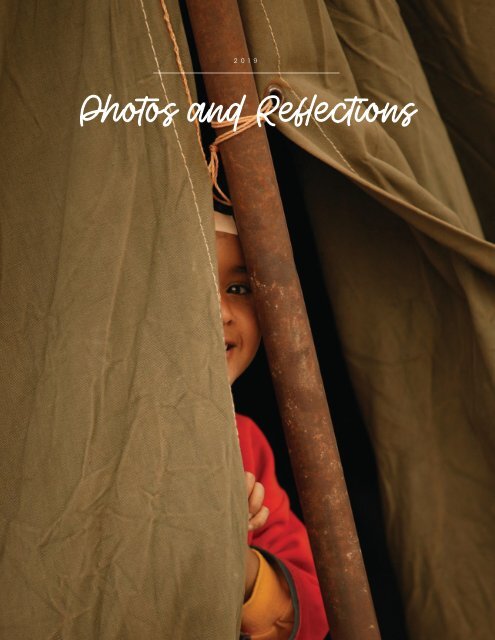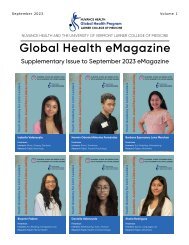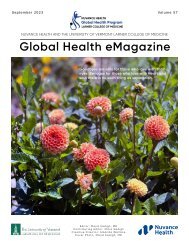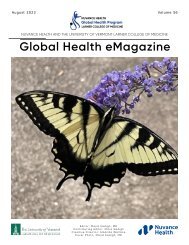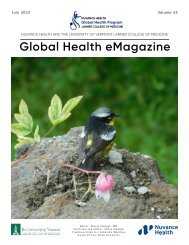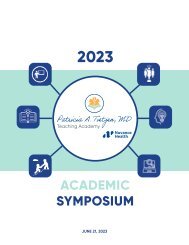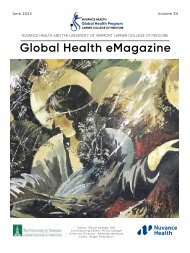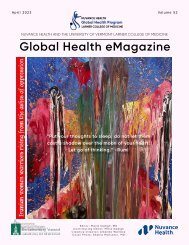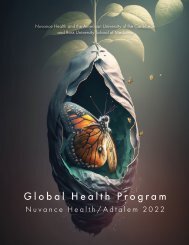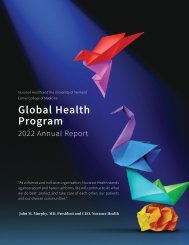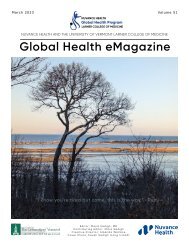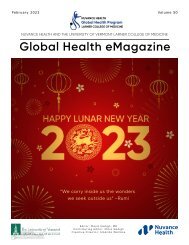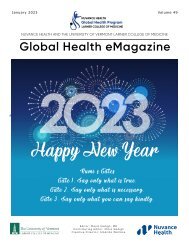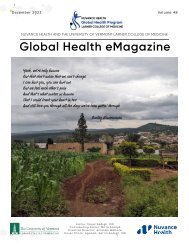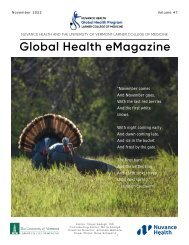Reflections Magazine yumpu
Create successful ePaper yourself
Turn your PDF publications into a flip-book with our unique Google optimized e-Paper software.
2019<br />
Photos and <strong>Reflections</strong>
REFLECTIONS 2019<br />
Table of Contents<br />
The Gate 6<br />
Butabika Psychiatric Hospital 8<br />
Organda Family, My Dominican Family 10<br />
Sexual and Reproductive Health Rights 12<br />
No Such Thing As Equal Opportunity 16<br />
Finding Home 20<br />
This Week I Met Anthony 24<br />
A Beautiful New Year 25<br />
Kilimanjaro 30<br />
Paying it Forward 36<br />
In “Dream Time” 38<br />
Flowers of Guatemala 40<br />
Contest<br />
Winner<br />
In Awe 44<br />
The Most Thoughtfully Composed Photo:“Leaving Clinic in Engeye” in Edegaya, Uganda<br />
(Dr. Anya Koutras, Associate Professor of Family Medicine, UVMLCOM)<br />
Produced by the Nuvance Health / University of Vermont Larner College of Medicine Global Health Program<br />
Editor: Mitra Sadigh<br />
Creative Director: Amanda Wallace<br />
Front Cover: Untitled (Photo credit: Keyvan Behpour of Kvon Photography)
PHOTOS AND REFLECTIONS 2019 PHOTOS AND REFLECTIONS 2019<br />
Introduction<br />
The Value of<br />
Sharing Stories<br />
Contest<br />
Winner<br />
WRITTEN BY MITRA SADIGH<br />
Writer, Editor, and Researcher at the Nuvance Health / University of Vermont Larner College of<br />
Medicine Global Health Program, and editor of the Global Health Diaries blog<br />
Participants of the Nuvance Health / University<br />
of Vermont Larner College of Medicine Global<br />
Health Program, including students, residents,<br />
faculty, and administrators, write to reflect on<br />
what they’ve seen, felt, and thought each week<br />
during the course of their global health elective.<br />
From clinical to cultural insights, observations to<br />
inquiries, each of these pieces helps elucidate<br />
the humanity in medicine. In this booklet, we<br />
share a collection of pieces that have moved us.<br />
Well Child Visits as Engeye in Edagaya, Uganda (Photo credit: Dr. Anya Koutras, Associate Professor, Family Medicine,<br />
UVMLCOM). Selected as Most Original Photo at the 2019 UVMLCOM Global Health Day<br />
Participants of the global health elective at the Nuvance Health / University of Vermont<br />
Larner College of Medicine Global Health Program, including students, residents, faculty, and<br />
administrators, write reflections about what they’ve seen, felt, and thought each week. From<br />
clinical experiences to cultural insights, contemplative observations to investigative inquiries,<br />
each of these pieces has helped shape and define our collective Global Health Diaries. In this<br />
booklet, we share some of the pieces that have moved us most. We hope that these deeply<br />
personal accounts will incite a similar spirit of reflection in you, be it in finding aliveness in the<br />
contours of these stories or drawing from that of your own.<br />
As editor of Global Health Diaries, where these<br />
reflections originally appeared over this last<br />
year, I often ponder why we feel compelled to<br />
share our stories and absorb those of others.<br />
After poring over the moments held in this<br />
collection, I feel that perhaps in so doing, we feel<br />
affirmed in the shared qualities and experiences<br />
that define what it is to be human.<br />
The stories in this collection retell experiences of deeply relating to new cultures, forging<br />
family connections with new individuals, and feeling home in new places. Experiences of<br />
questioning and reshaping our deeply held views. From a leprosy center in Thailand to<br />
a psychiatry ward in Uganda, mountainside in Tanzania to beachside in the Dominican<br />
Republic, they show us that despite our differences, we all understand pain, loss, illness,<br />
and vulnerability as we connect in shared suffering. We all understand compassion,<br />
acceptance, care, and community, as connected in shared love and humanity.<br />
It is from this sacred place of shared humanness that we can care compassionately for<br />
each other.<br />
4 5
PHOTOS AND REFLECTIONS 2019 PHOTOS AND REFLECTIONS 2019<br />
The Gate<br />
WRITTEN BY ISAAC DE LA BRUERE<br />
University of Vermont College of Medicine Class of 2022<br />
I am 63 years old<br />
If you asked me, I would say that I am happy<br />
I have friends<br />
A new family<br />
A gate.<br />
I pick mangoes with my neighbors<br />
And we help each other cook meals<br />
We play cards<br />
And gamble with rambutans<br />
Behind the gate.<br />
We yell at the futbol players on the old tv during matches at lunch<br />
And sit together as the sun turns the treetops to gold<br />
I help some of the older residents walk home in the dark<br />
And say good night when it gets late<br />
Sometimes<br />
Before sleep claims me<br />
I remember my mother<br />
And how she looked at the floor when my father told me I had to leave<br />
I was 18<br />
When I became a leper<br />
And first saw the gate.<br />
During the day I miss my fingers<br />
And try to recall the ease of twisting a doorknob<br />
But at night I remember her<br />
And try to recall the feeling<br />
Of my mother’s arms around me<br />
On the other side of the gate.<br />
This poem came to me after our visit to the Phud Hong<br />
Leprosy Community near our town in Thailand. It was an<br />
incredibly powerful experience to see how its members<br />
have adapted to life within their community. All the<br />
residents are elderly, as there have been very few new<br />
cases of leprosy in the region in the last couple of decades.<br />
Many members have been there for the past forty years,<br />
sharing with us stories about how they were isolated and<br />
cast out from their families and communities when they<br />
were first diagnosed. It is a disease with a terrible stigma,<br />
especially back in the 1960s and 1970s when many of the<br />
people we spoke with first contracted it.<br />
For many years, members of the Phud Hong community<br />
were not allowed to interact freely with the surrounding<br />
town, and very few people came to visit them. Today,<br />
however, modern medication has eradicated the bacteria<br />
from their bodies and made them non-contagious,<br />
allowing them to come and go as they please. Many,<br />
however, have found that they still prefer life within their<br />
community compared to the outside world. I wrote this<br />
poem from the imagined perspective of an older member<br />
in the late 1990s or early 2000s when the community was<br />
still gated, and based on some of the testimony we heard<br />
during our visit.<br />
In Thailand, the family unit comprises an extremely strong<br />
bond. Having that broken, as some members described<br />
to us, and being disowned by the very people that are<br />
supposed to love and support you unconditionally is<br />
something that really hit home for me. I first imagined<br />
rage and fury as the predominant emotions. But many<br />
members spoke of feeling an indescribable sadness<br />
rather than anger. Here, I’ve imagined what someone who<br />
has gone through this thinks about when they are alone<br />
with their thoughts at night, and the emotional rigidity of<br />
daytime gives way to the melancholy cover of darkness.<br />
Old Man with Leprosy (Photo Credit Eunice Fu)<br />
6 7
PHOTOS AND REFLECTIONS 2019 PHOTOS AND REFLECTIONS 2019<br />
Butabika Psychiatric<br />
Hospital<br />
WRITTEN BY BRIAN ROSEN<br />
University of Vermont Larner College of Medicine Class<br />
of 2019<br />
The entrance gate is manned by a psychiatric patient dressed in the simple blue-green patient garb, letting<br />
his fellow patients enter or leave based on what appears to be whim. Within the walls, patients meander<br />
about in states of extreme psychosis and mania without any real attempt to intervene in case of conflict.<br />
Sanitation appears as an afterthought, causing the smell of human suffering to be fully entrenched in my<br />
emotional memory. Due to the limited security structure, walking around the grounds of Butabika means<br />
constantly running into patients in the acute throws of psychosis walking aimlessly around the grounds<br />
as though in a perpetual daze. The resulting impression is one of extreme despair and powerlessness.<br />
Due to resource constraints, the medications provided to such patients are restricted to first-generation<br />
antipsychotics that produce a wide variety of symptoms including repetitive motions of the limbs or face,<br />
drooling, and extreme sedation and lethargy.<br />
Winner of the 2019 UVMLCOM Global Health<br />
Day Reflection Contest<br />
I excel at intellectualization. It is a fickle defense<br />
mechanism, allowing the observer to fully comprehend<br />
the situation in front of them without fully engaging in<br />
the emotional context. Throughout my medical training,<br />
intellectualization has aided me at many patient bedsides<br />
and through emotionally charged family conferences. I<br />
am reminded of many moments on neurology wards<br />
when a patient’s emotionally charged question was<br />
reinterpreted and deflected through a purely intellectual<br />
and biological lens. The disease process was stripped of<br />
its emotional and societal resonance and presented as<br />
a simple fact of life. My habit towards intellectualization<br />
even followed me into psychiatry, a field that fully<br />
embraces the nuances and significance of human<br />
emotion. It is much easier to intellectualize a difficult<br />
patient encounter with the Diagnostic and Statistical<br />
Manual of Mental Disorders (DSM) qualifiers or neuronal<br />
processes than it is to simply exist in a difficult moment<br />
and let in the anxiety and fear that often accompany it.<br />
Even this introduction to my experiences at Butabika<br />
Psychiatric Hospital is an intellectualization. It is my<br />
attempt to analyze and appreciate the defense<br />
mechanism that served me so well and yet has likely met<br />
its match. The human suffering that I recently witnessed<br />
has affected me greatly. Before arriving in Uganda,<br />
I imagined rough caricatures of what I may expect.<br />
Having been pre-warned that conditions in inpatient<br />
psychiatry are below what one would find in the United<br />
States, images of classic asylums immediately came to<br />
mind.<br />
Contest<br />
Winner<br />
My conception of such places comes intellectually<br />
from history books or visually and culturally<br />
from films such as One Flew Over the Cuckoo’s<br />
Nest. Even given the challenging environment<br />
I imagined, I was unprepared for the visceral<br />
nature of my experience. Butabika is located<br />
about thirty minutes from the center of Kampala,<br />
Uganda. It is situated on a lush hill overlooking<br />
the tranquil countryside. The peaceful quality of<br />
the environment is perhaps a prerequisite given<br />
the scenes that often occur within its walls. Each<br />
psychiatric ward is a separate one-story building<br />
spread generously across the sprawling facility.<br />
Psychiatric patients are divided into childadolescent,<br />
forensic, addictions, acute care, sick<br />
care, and convalescent (stable) care categories.<br />
The general physical upkeep and atmosphere of<br />
each ward varies dramatically. The acute male<br />
ward is my worst fears brought to life before my<br />
eyes.<br />
Compounding this is the extreme lack of social work or societal support available to the patients here.<br />
Patients are often dropped off by family members in acute states of psychiatric illness and simply left to<br />
become wards of the state. Quantitative medical tests like thyroid levels, lithium levels, or computerized<br />
tomography (CT scans) are provided only if the patient can directly pay. Given that patients with mental illness<br />
are statistically likely to be less educated and more impoverished, this reality is criminally disheartening. In<br />
contrast to the patient-centered care preached in the United States, encounters at Butabika have often felt<br />
like paternalism come alive. Ward rounds can sometimes feel closer to tribunals in which medical decisions<br />
are decided and read aloud without direct patient involvement.<br />
“Compounding this is the extreme lack of<br />
social work or societal support available<br />
to the patients here.”<br />
Amidst this environment, I have felt true despair of the variety that I cannot easily intellectualize away. I<br />
struggle to understand a system that, due to its resource constraints, treats patients in a manner to which<br />
I am simply not accustomed. My discomfort participating in psychiatric care at Butabika is immense and<br />
yet I wonder if my own standards are too unreasonable given the constraints on-the-ground. Am I justified<br />
in my fear and discomfort or am I simply “othering” another system? I have been questioning my emotions<br />
and feelings since beginning my time on Butabika’s grounds but have yet to find an answer. Yet maybe that<br />
questioning and understanding is unnecessary. By explaining away my feelings and concerns, am I simply<br />
looking for a way to intellectualize my anxiety? I am left with the hope that one day I will make meaning<br />
from my inpatient experiences in Uganda. Until that time, I will simply sit with the discomfort that I now feel.<br />
8 9
PHOTOS AND REFLECTIONS 2019 PHOTOS AND REFLECTIONS 2019<br />
Organda Family,<br />
My Dominican<br />
Family<br />
WRITTEN BY ANTONIA NWANKWO, BS, COA<br />
Ross University School of Medicine Class of 2019<br />
I’ve heard people frequently ask why American children leave the house and move away so quickly.<br />
I’ve really been reflecting on this lately as I consider a location for residency and decide where I<br />
want to spend the next three to five years. I was once one of the “typical” American kids that rushed<br />
to be on my own at eighteen. I’m grateful for the independence I’ve gained, but my perspective on<br />
the support of family has changed. I now deeply value it. My Dominican family has been amazing.<br />
In the house are Mami Marissa, Papi Jesus, and Wellington. Nearby in the next building is our sister<br />
Esmeralda, her husband Dandy, and the family’s first grandchild, their daughter Zoe. I see Esme and<br />
Zoe every day. Mami looks after Princess Zoe before and after school until Esme gets off work. The<br />
system they have built works very well.<br />
Like any other three-year-old, Zoe definitely wants everything her way. She’s rather entertaining. I<br />
play with her often, watching her dolls die and come back to life after a fall from the mountain that<br />
is the dining room table. She’s quick to correct my Spanish and bribe me to play with her. Wellington<br />
is like any other brother: we see him when it’s time to eat. Jesus works as a school gym teacher<br />
and makes sure we have plenty of activities to engage in. He’s taken me on tours, introduced us to<br />
his friends, and sat down to carve out some “father-daughter” time with a beer. Just like any other<br />
parent, he worries when we are out and stays up until we arrive home, even though he attempts to<br />
act like he doesn’t.<br />
Mami doesn’t speak much English but we have conversations through body language and the bit of<br />
Spanish I have picked up along the way. She takes pride in cooking our meals, arranging them just<br />
as she would in the restaurant she used to run. Marissa is a fantastic woman who treats me just like<br />
her own child. The love she shows every day is so genuine. I love that the house is filled with noise, as<br />
it makes me think of memories I’ve shared with my own family. I deeply appreciate the dynamic they<br />
share. No matter what everyone is doing, they all come home for lunch and dinner.<br />
RUSM students Antonia Nwankwo (left) and Samantha Boustani (right) with Maritza and Jesus Organda (host family in middle)<br />
I think we often get so caught up in living that we don’t take the time to enjoy the people we are living with.<br />
Our host family took us in like their own. We celebrated Esme’s pregnancy with a gender reveal party attended<br />
by friends and family. I was traveling that weekend but I made sure to be there because she is my sister. We<br />
have different personalities but it works so well. Our birthdays are even on the same exact day! I wasn’t<br />
expecting to be so emotional about leaving. The bond we have built is solid, and the foundation set in stone.<br />
This family shows their love for each other in multiple ways and has gone the extra mile to make sure we feel<br />
this in every way. The experience with this family has grounded me and reiterated why being together is the<br />
center of a strong family.<br />
10 11
PHOTOS AND REFLECTIONS 2019 PHOTOS AND REFLECTIONS 2019<br />
Sexual and Reproductive<br />
Health Rights<br />
WRITTEN BY FLORENCE DIBIASE<br />
University of Vermont Larner College of Medicine Class of 2019<br />
“You should see the stuff they stick up there… I’ve seen<br />
coat hangers, sticks, and bicycle spokes.”<br />
- A fifth-year medical student at Makerere University<br />
College of Health Sciences in reference to treating<br />
septic abortion patients<br />
As a future Ob/Gyn provider, I maintain a strong<br />
commitment to the fundamental rights of women.<br />
Beyond her basic right to gender equality and respect,<br />
I believe in a woman’s right to accessing safe and<br />
legal abortion as well as deciding how many children<br />
to have and when. I want to provide these services as<br />
a doctor. Every woman has a right to safe, consensual,<br />
pleasurable, and fulfilling sexual relationships. She<br />
should have access to information and options for<br />
both contraception and safe termination should she<br />
require them.<br />
Reproductive rights are hard enough to discuss in the<br />
U.S., especially in certain social circles, often sparking<br />
heated arguments and tense emotions. Multiple<br />
legislative efforts against abortion are proposed<br />
weekly in a variety of U.S. states, while other states<br />
work hard to protect these rights. President Trump<br />
is attempting to pass exemptions that can restrict<br />
women’s access to birth control. Last week, his State of<br />
the Union Address also referenced ending “late-term<br />
abortions,” a misleading term that was actually meant<br />
Untitled (Photo credit: Picasa)<br />
12 13
PHOTOS AND REFLECTIONS 2019 PHOTOS AND REFLECTIONS 2019<br />
to represent twenty-one- to twenty-four-week abortions rather than those in women about to give birth.<br />
Of course, it pleased anti-abortionists and kept the tension high. I digress. I recognize my opinions on these<br />
issues are strong—I will readily debate with those who disagree with me and fight for what I believe is right.<br />
That said, I am still assessing how to uphold these beliefs in the global health context.<br />
Prior to coming to Uganda, I researched reproductive rights here on the Guttmacher Institute webpage. The<br />
birth rate is one of the highest in the world at 5.59 births per woman (2016). Unintended pregnancy is<br />
common, leading to high rates of unplanned births. Premarital sex is common, with more than one-third<br />
of women aged fifteen to twenty-four having had sex. One-quarter of adolescents age fifteen to nineteen<br />
have had a child. Modern contraceptive use remains low at twenty-six percent of married women and<br />
forty-three percent of sexually active unmarried women.<br />
Abortion is mostly illegal in Uganda. The law makes an exception in the case of endangerment of a woman’s<br />
life, and in 2006, National Policy Guidelines were passed that further permitted abortion under certain<br />
circumstances such as rape and incest, HIV infection, and cases of fetal anomaly incompatible with life.<br />
That said, abortion laws are interpreted inconsistently by law enforcement and because of this ambiguity,<br />
medical providers are often reluctant to perform the procedure. In 2013, the abortion rate in Uganda was<br />
39/1,000 for women aged fifteen to forty-nine. This translates to an estimated fourteen percent of all<br />
pregnancies ending in abortion. This rate is even higher in Kampala specifically, at 77/1,000 women.<br />
The same study showed 12/1,000 women are treated annually for complications resulting from unsafe<br />
abortion. While maternal mortality is decreasing (it dropped from 684/100,000 live births in 1995 to<br />
343/100,000 in 2015), unsafe abortion remains a significant contributor to mortality. The Ugandan Ministry of<br />
Health estimated eight percent of maternal deaths were due to unsafe abortion in 2010. Meanwhile, postabortion<br />
care is estimated to cost nearly $14 million USD annually. Studies show that restricting access to<br />
abortion does not decrease its incidence, but merely makes it more dangerous and deadly for women<br />
around the world due to unsafe method use. It saddens me that we have inexpensive and safe methods to<br />
prevent unintended pregnancy and perform early terminations, but many women continue to die due to<br />
lack of access, implementation, social stigma, or other barriers.<br />
I have now been at Kawempe General Hospital for three weeks. I initially carefully avoided the subject of<br />
reproductive justice altogether, determined to wait to ask questions until I gained a better sense of cultural<br />
attitudes. From the Ugandans I have met thus far - primarily the Okullo family and surrounding medical<br />
students on their Ob/Gyn rotation - religion is a vital component of life here. We pray with the Okullo family<br />
before most meals, and they regularly reference God. A few medical students have asked me if I am Christian.<br />
It is interesting to consider how the origins of Christianity and other common religions in Uganda came from<br />
Western influence when Uganda was under European rule. Western influence continues to be present today,<br />
in part due to lasting impressions from that time and in part due to the opening of the country’s borders<br />
during the initial HIV epidemic. I am trying to observe how this religious influence has been adapted to<br />
fit the realities of East Africa and shapes cultural values. I imagine this contributes significantly towards<br />
attitudes regarding reproductive rights.<br />
I have not heard much regarding abortion in my work at the hospital. It has been difficult to tease out the<br />
attitudes of healthcare providers. When I have hinted at topics to medical students, it has not encouraged<br />
enlightening conversation. One cannot expect to learn all the nuances of a new culture in three weeks,<br />
especially with such personal topics. As I am a guest here still trying to understand cultural attitudes, I am<br />
trying to avoid asking potentially offensive questions surrounding the topic of reproductive rights.<br />
This week, however, I attended a lecture titled “Sexual and Reproductive Health Rights.” I saw this on the<br />
schedule and felt curious about how it would go. The general format of lectures in the fifth year medical<br />
student class involves one or two students presenting daily assigned topics with facilitation by an attending.<br />
This lecture was given by a timid appearing male student who started with similar statistics to those I<br />
referenced above. The attending facilitator, a female physician, chimed in frequently. As the discussion<br />
turned to abortion, I felt at times that the attending’s attitude was very liberal, yet at times, I also disagreed with<br />
her views. When she asked whether abortion should be legal, the class mostly responded in the affirmative,<br />
which somewhat surprised me. The professor, however, stated that legalizing abortion would not be effective.<br />
She proceeded to share her view that legalizing abortion would not make it accessible to the majority of<br />
women desiring it due to costs, stigma, and lack of willing providers. She spoke about South Africa’s abortion<br />
legalization and the country’s subsequent struggle with its implementation for these reasons. She clearly<br />
acknowledged the reality of the problem. I wrote in my notebook her statement: “the men who say abortion is<br />
illegal are the same men who get women pregnant.” She gave case examples of patients she had treated with<br />
septic abortion. One woman she treated had the procedure performed by a non-licensed medical person<br />
who probed so far into her abdomen that they went through the uterus and into the bowel, only realizing their<br />
mistake when they started pulling feces out of the vagina.<br />
She argued instead for prevention through education of all women and access to effective contraception for<br />
anyone who becomes sexually active. She stressed keeping girls in school as a fundamental way to decrease<br />
the high birth rate, unintended pregnancy, and maternal mortality. This is a more realistic and achievable<br />
goal, she argued, given that even access to contraception and sexual education are contentious due to<br />
religious and cultural beliefs. One example cited was about the Ministry of Health being forced to revise its<br />
statement on providing contraception to adolescents, raising the minimum age from ten to fifteen. Another<br />
student contributed to the discussion by bringing up the lack of sexual education offered to children. I would<br />
love to discuss this with him if I can find an appropriate time and place.<br />
This was my favorite lecture to date because it left me questioning how to establish a woman’s right to<br />
reproductive control in resource-limited and culturally prohibitive environments. I went into the lecture<br />
believing abortion should be legal everywhere, and I still maintain that belief, but I had not thought through<br />
all the logistical complications; the economics and cultural context in which laws operate. Of course I want<br />
women in Uganda to have access to abortion services if they want them, but maybe this lecturer is right?<br />
Perhaps the current situation is not sufficiently stable or developed enough to successfully implement such<br />
a law. This is a great challenge of any field or specialty within global health: when there are so many aspects<br />
of the healthcare system that require aid (in any form), how does one set an achievable and effective goal?<br />
Where does one direct efforts when one cannot address everything one would hope to?<br />
When I think about the environment at Kawempe General Hospital, I wonder too how many women are not<br />
accounted for in the statistics I read. It is resource-draining and time-consuming to perform data collection<br />
for things like the maternal mortality ratio and illegal abortion rates. I imagine many people are not accounted<br />
for in the census. Many women never go to healthcare centers for antenatal care or deliveries. The scope of the<br />
problem is depressingly large. That said, understanding the problem through data is the first step. An estimate<br />
is better than no estimate, and small successes are better than no success at all.<br />
With a ton of new international students arriving this week and flocking to the labor floor, I decided to explore<br />
gynecology a bit more having spent the majority of my time thus far helping with deliveries. I have been going<br />
to the family planning clinic, which is a much calmer environment but an equally valuable clinical experience.<br />
As I am considering family planning as a career focus, it has been rewarding to see this subspecialty through<br />
the lens of a Global South nation. With the start of the clinic, advanced nursing staff gives a presentation in<br />
Luganda about all the different contraception methods available. Then, women bring their blue family planning<br />
record cards to receive a particular method and/or cervical cancer screening. They use dilute acetic acid to<br />
identify premalignant/suspicious lesions of the cervix with referral to oncology if necessary for biopsy. The<br />
majority of women here seem to prefer copper intrauterine devices and implants as birth control. In helping<br />
with the insertion of contraceptive devices, I learned that while the Ministry of Health and Kawempe General<br />
Hospital are supportive of family planning services, women still fear stigma for using contraception.<br />
“Make sure you can’t see it,” one woman told me as we placed an implanon implant in her arm. “I don’t want<br />
people to know.”<br />
14 15
PHOTOS AND REFLECTIONS 2019 PHOTOS AND REFLECTIONS 2019<br />
Kaysha Ribao with Ahja Steele, medical<br />
student at Ross University School of Medicine,<br />
and James Ssewanyana, primary<br />
clinician at ACCESS Life Care Center as<br />
well as Co-Founder and Deputy Executive<br />
Director at ACCESS<br />
No Such Thing as<br />
Equal Opportunity<br />
WRITTEN BY KAYSHA RIBAO<br />
American University of the Caribbean School of Medicine Class of 2020<br />
The red dust is everywhere: on skin and clothes, in<br />
the car and the air. Despite the rain last night, today<br />
was particularly dusty as we partook in another<br />
Family Planning Outreach event. Although we<br />
started in the late afternoon instead of our regular<br />
morning start time, I began to understand why. It<br />
was the beginning of farming season, which means<br />
women work until late afternoon before returning<br />
home to complete chores. With farming composing<br />
their main livelihood, it was pertinent that we work<br />
around their schedules.<br />
Communication is key to any event, and Ugandan<br />
social media includes loudspeakers and lively<br />
music. As we sat on the grass under the tree as our<br />
advertisement played in the small village, I spoke<br />
to Charity, a security guard at ACCESS who had<br />
joined us. She described her dream of becoming<br />
a nurse, and the reality that she could not afford<br />
the school fees, especially with five siblings. Costs<br />
(1 USD = 3,600 shillings) include 200,000 shillings<br />
for primary school, 300,000 shillings for secondary<br />
school, and 500,000 for university, not to mention<br />
the meager income for each family. She believes<br />
it is her responsibility to pass her dreams on to<br />
her younger siblings and support them in their<br />
endeavors. According to Deo, our driver, there is no<br />
such thing as loans in Uganda. It was then clear to<br />
me that there is no such thing as equal opportunity.<br />
16 17
PHOTOS AND REFLECTIONS 2019 PHOTOS AND REFLECTIONS 2019<br />
As I make my way through Paul Farmer’s Pathology of Power, things are starting to make sense. Poverty is<br />
essentially the cause of the injustices I observe, as a lack of resources pushes individuals to vulnerable situations<br />
in order to simply survive. Poverty excludes the poor from receiving an education, which is essential for finding<br />
a stable job and having an influence in the community. It leaves individuals malnourished, which renders them<br />
vulnerable to sickness and disease. The village children caught my eye as they ran around playing and taking<br />
care of each other with muddy bare feet, yellow snot, and dirty clothes that barely covered their thin bodies.<br />
These observations make me feel helpless and frustrated. As a systemic issue, poverty requires a systemic<br />
solution. Poverty pushes the poor to the point of anger or despair, leading to political upheaval and eventually<br />
civil war. War brings on violence, which further exacerbates human rights violations—sexual assault, torture,<br />
displacement, and hunger. Deo explained that the war in Uganda left him orphaned, but that he was cared for<br />
by relatives, bringing meaning to the phrase “it takes a village to raise a child.” However, many others were not<br />
so lucky.<br />
Contest<br />
Winner<br />
Untitled (Photo credit: Albert Trondin)<br />
: Untitled (Photo credit: Scott Mitchell)<br />
Selected as Most Impactful Photo at the 2019 UVMLCOM Global Health Day<br />
18 19
PHOTOS AND REFLECTIONS 2019 PHOTOS AND REFLECTIONS 2019<br />
Finding Home<br />
WRITTEN BY RAY MAK<br />
University of Vermont Larner College of Medicine Class of 2022<br />
Where is home for you? If I had to pin a physical location, I<br />
would consider Southern California my home. Though I<br />
only lived there for four years in college, they were the best<br />
years of my life. I felt truly at home. For some, home isn’t<br />
defined by where you grow up, how long you’ve lived in<br />
a particular place, or where your parents chose to settle<br />
down. Rather, it’s measured in the love and safety to<br />
nurture your authentic self. For me, home is not held in a<br />
physical space, but within the circles of people I hold close<br />
to me. Home truly is where the heart is and unexpectedly, I<br />
left a piece of my heart in Thailand this summer.<br />
Upon arriving at Walailak University in Southern Thailand,<br />
we were welcomed with open arms. Thai hospitality is<br />
incredible: there was always somebody to show us around<br />
and take us out for food. There is a culture of giving and<br />
looking after one another, even among strangers. For<br />
instance, as I was leaving a roast duck shop, one of the<br />
cooks ran after me to hand me a bag of mangosteens, a<br />
common tropical fruit in Thailand. Her generosity caught<br />
me by surprise, and I had done nothing to deserve it. I<br />
didn’t know how to respond at first. At a loss for words, all I could say was “khàawp khun krap,” or “thank you,”<br />
one of the few Thai phrases I picked up. Although not being able to speak the local language felt isolating<br />
at times, the kindness of strangers was touching.Walking into a restaurant near the university, a woman the<br />
students refer to as “Auntie” came out to greet us and take our order. As a Chinese-American, I grew up with<br />
a similar custom of calling everyone my parent’s age “Auntie” or “Uncle” even if we were not blood-related.<br />
In terms of student-professor relationships, I learned that it’s normal for students to text their professors,<br />
and even the dean of the medical school, whenever they need anything. The dean wants us to call him “Pee<br />
Menn,” meaning “big brother Menn,” implying that we are all family and here for each other despite the<br />
differences in our backgrounds and upbringings. It’s hard for me to imagine normalizing this level of comfort<br />
in the U.S. where I was hesitant to even email my college professors, fearing that I would be a bother and take<br />
up too much time in their busy schedules. There’s a sense of closeness and connectedness in rural Southern<br />
Thailand that doesn’t exist as prominently in the U.S. where things are more “everyone for themselves.”<br />
Independence is valued in American culture, rendering it acceptable to settle down far from home. On the<br />
other hand, maintaining strong family ties is a common theme in Asian cultures. From speaking with Thai<br />
medical students, I found that they often feel homesick while studying at Walailak. However, one reason why<br />
many choose to study there is that the school strives to train doctors from underserved areas of Southern<br />
Thailand so that graduates can return to their hometown and serve the community they grew up in. To<br />
Ray Mak dining with Global Health Program participants and “Auntie” (Photo credit: Ray Mak)<br />
cope with being away from home, students say that they treat their peers and mentors like a<br />
second family. As someone who found chosen family in college, I can deeply relate.<br />
The summer before college, home was a foreign concept to me. My parent’s house was not<br />
the place for me to live as the person I wanted to be. When I told my parents that I was<br />
transgender, they expressed their disapproval and an already-difficult relationship turned into<br />
four years of estrangement after moving out for college. I remember sitting in my pediatrician’s<br />
office, trying to verbalize why living with my parents was becoming unbearable. Luckily, my<br />
doctor understood me and argued with them that there was nothing inherently wrong with<br />
me wanting to live as my authentic self. Though they didn’t listen, I found comfort in knowing<br />
that at least my doctor was on my side. To this day, it’s been a challenge to bring my parents<br />
along in my journey of transitioning.<br />
Hearing the stories of patients at Phud Hong Leprosy Center, I saw how our experiences<br />
paralleled. It was less than a lifetime ago that leprosy was heavily stigmatized. Those afflicted<br />
with the disease became social outcasts, forced to leave home and quarantined to a leprosy<br />
facility. People believed that the disease was punishment for a horrible action in a past life.<br />
Leprosy patients were turned away even by friends and family. My heart wanted to leap out and<br />
pour the love that they had been missing through all the years, but it would have been too little,<br />
too late. Over the past few decades, effective treatment for leprosy has become available and<br />
our understanding of the disease has progressed significantly, but the debilitating effects on<br />
survivors still remain. They are left with varying degrees of facial deformities, muscle atrophy,<br />
limb amputations, and psychological trauma.<br />
20 21
PHOTOS AND REFLECTIONS 2019 PHOTOS AND REFLECTIONS 2019<br />
years of trauma and rejection. Like physical scars, the emotional scars last forever. You can still hear the<br />
pain in their voices as they recount their stories. Despite the suffering, there was a beauty in how patients<br />
supported each other through difficult times and bonded over their shared experiences. As we toured their<br />
living space eating fruit off the trees that they tended to, I was struck by a community brought to life. This<br />
was home for them: a place to feel safe among chosen family that they could call their own.<br />
That day, I found a struggle that resonated within me. I was immensely grateful for the opportunity to interact<br />
with these patients. I fell in love with their stories, their resilience, and their audacity to continue living and<br />
sharing their lives with people like me despite their unfortunate circumstances. These patients will continue<br />
to be an inspiration in my pursuit of medicine. I hope I can be just as inspirational and uplifting for others<br />
one day.<br />
Ray Mak with residents of the Phud Hong Leprosy Center<br />
The most valuable teaching from this day was that it<br />
reminded me why I chose medicine in the first place.<br />
Among the many stories, one patient shared his<br />
surprise when one doctor in particular was not afraid<br />
to touch him and treat him like a human being. When<br />
the rest of society turned him away, this encounter<br />
gave him faith in the world as he knew he would be<br />
well taken care of. This is the kind of hope I want to<br />
give my future patients. I chose medicine to be a<br />
part of the change in healthcare for marginalized<br />
communities. Doctors are in a position to see how<br />
health touches the many aspects of a person’s life,<br />
and it is our job to treat the person as a whole. When<br />
a patient has hit their low point, I want to be by their<br />
side and fight for them to see better days just as my<br />
doctor did for me.<br />
Presently, leprosy patients at Phud Hong Leprosy<br />
Center are free to leave and see their loved ones in<br />
the outside world, but many choose to stay because<br />
they are unable to reintegrate into society after the<br />
Banasan sunrise (Photo credit: Ray Mak)<br />
At the end of our rotation, we gave a presentation on our experience in Thailand to an audience that included<br />
the dean of Walailak and other school officials. I chose to talk about how my experiences being transgender<br />
allowed me to empathize with marginalized communities, and especially how our day at the leprosy clinic<br />
reminded me of my inner drive. I wasn’t sure what people’s reactions would be, but it felt like a disservice to<br />
myself and my audience to not tell my truths. I took a leap of faith based on the kindness and understanding<br />
that seems so deeply rooted in Thai culture. Afterward, several people expressed that they appreciated my<br />
presentation. The dean even hugged me, saying that I was very brave for sharing my story.<br />
That was when it hit me: I had found a new piece of home at Walailak University, a place that has nurtured<br />
my soul and allowed me to grow into a better version of my true self. I was inspired to continue the generosity<br />
of others by paying it forward, connecting with others as if we were family, and unapologetically falling in<br />
love with inner strength. These are the lessons that I will carry with me for the rest of my life.<br />
22 23
PHOTOS AND REFLECTIONS 2019 PHOTOS AND REFLECTIONS 2019<br />
This Week I<br />
Met Anthony<br />
A Beautiful New Year<br />
WRITTEN BY LAURI LENNON<br />
Director of Business Operations at Nuvance Health<br />
WRITTEN BY<br />
JOSE CALDERON<br />
University of Vermont Larner College of Medicine Class<br />
of 2022<br />
This week I met Anthony, not at the hospital or clinic, but beachside as I was enjoying a cold Corona and a<br />
delicious seafood paella. Although it was August, Anthony was selling heart-shaped Valentine’s Day-themed<br />
lollipops. I saw him go to each dining table one by one, only to be rejected what seemed to be nine out of ten<br />
times. When he reached my table, instead of just buying the lollipop for 25 cents, I asked if he was hungry and<br />
would like to join us for dinner. He was shy at first and politely declined the invitation, but eventually sat down<br />
and joined me after I said the food was entirely way too much for me to eat on my own.<br />
January 1, 2019, I began to organize for my trip to Uganda. I ordered a few things off Amazon: bug spray, a safari<br />
hat, a small rechargeable fan, etc. I changed my Facebook cover picture to the Ugandan flag, which features<br />
a pattern of black, yellow, and red stripes that repeats twice, forming six equal horizontal bands with a grey<br />
crowned crane—the national symbol—at its center. Black for the people of Africa, yellow for the sunshine<br />
of Africa, and red for the brotherhood (color of blood) of the African people, through which all Africans are<br />
connected. The grey crowned crane is known for its gentle nature, with its raised leg symbolizing the forward<br />
movement of the country. I think of the gentle and soft-spoken nature of the Ugandan colleagues who have<br />
visited the U.S. The grey crowned crane must be a beautiful bird.<br />
I learned that Anthony is fourteen years old, lives with his mother<br />
and grandmother, and doesn’t know much about his father. I<br />
learned that he works twelve-hour days, from 9 am to 9 pm. I<br />
learned that he makes on average four USD a day, two-thirds of<br />
which goes to his family. I learned that right now he’s working a<br />
little extra because he has to buy school supplies since classes will<br />
begin shortly.<br />
I learned that Anthony doesn’t want to sell lollipops his whole life.<br />
When I asked what he wanted to study when he grows up, he said<br />
dentistry and possibly photography. I encouraged him to follow his<br />
dreams and told him I was proud of him. In this short meal, I not only<br />
learned that Anthony was hungry but too shy to admit it, but I also<br />
learned about his life and personal struggles. He reminded me of<br />
the times when I myself went door-to-door asking people if I could<br />
cut their yard for a few bucks, as I needed new shoes before school<br />
started and this was my only option. I was also fourteen. Anthony is<br />
another constant reminder to value what I have. I hope everything<br />
works out for him.<br />
(Photo credit: Jose Calderon)<br />
Kampala’s streets (Photo credit: Laura E. Smith)<br />
24 25
PHOTOS AND REFLECTIONS 2019 PHOTOS AND REFLECTIONS 2019<br />
As I look out the window, I can’t believe my eyes and the<br />
plethora of activities surrounding me. There are people<br />
EVERYWHERE in Kampala: on the main streets, side<br />
streets, in stores, outside of stores—people sitting and<br />
laughing and doing laundry in a bucket, people cooking<br />
on small fires. Everyone is dressed superbly, whether<br />
in the city or in a village. Dress might be soiled from a<br />
day’s hard work in the village, but the inherent sense<br />
of style is beautiful to my eyes. The smells remind me<br />
of summer barbeques roasting marshmallows by an<br />
open fire. My eyes fill with tears. What a beautiful place!<br />
Lauri Lennon with Laura E. Smith, Global Health Coordinator<br />
at Nuvance Health, and Susan Byekwaso, Coordinator of the<br />
International Office at Makerere University College of Health<br />
Sciences<br />
Kampala is an exciting city! It’s alive and well and never<br />
sleeps, much like New York City. Roads aren’t paved<br />
with concrete but are rather packed with beautiful red<br />
dirt. Each business is lined in a tightly knit formation, all<br />
in a row, in brick buildings. Merchandise is laid out on<br />
handmade African mats, mannequins, or sometimes<br />
on the head of a very talented African man or<br />
woman. It’s all there! Cell phones, clothing, produce,<br />
meat, hardware stores, hair salons, furniture stores,<br />
supermarkets, places to eat, pharmacies, construction<br />
companies, night clubs, and even places to purchase<br />
coffins! A car clearly labeled “Driving School” makes<br />
me wonder how young men and women in the U.S.<br />
would handle driving on Kampala’s streets. The roads<br />
are full of matatus, with people packed from top to<br />
bottom and front to back, and boda bodas on which up<br />
to 4-5 people ride at once, and helmets worn only by<br />
the driver. There are little to no traffic rules, but people<br />
simply make it work without yelling, cursing, or honking.<br />
During our stay in Kampala, we are hosted by two<br />
wonderful, caring, and loving families: the Okullos and<br />
the Lubogas. We are treated like kings and queens.<br />
Each evening, we are welcomed with a warm heart and<br />
honest gesture of “How was your day? You must be very<br />
tired.” “Welcome home” is an understatement to say<br />
the least. We are home in their homes, never feeling<br />
like guests or strangers. We are treated like family, and I<br />
quickly become fast friends with the women helping run<br />
the homestay. I wake up at sunrise one morning to the<br />
Muslim prayer. The only time I remember hearing this is<br />
on the HBO series “Homeland.” As I lay in bed listening, I remember to stay in this moment and appreciate<br />
how blessed I am to be on this journey.<br />
In Kampala, we spend a considerable amount of time at the orphanage, Sanyu Babies Home. I look around<br />
and smile as we are all engaged with the children: holding and/or feeding an infant, wiping the runny nose of<br />
a toddler, throwing a ball to a child, or pushing as many toddlers on the swing as we can, remembering there<br />
are only three swings but ten to fifteen anticipating toddlers! I admire the mamas who care for the children<br />
every day. They are making such a difference. It’s hard to leave. I make a mental note to spend more time at<br />
the orphanage during my next visit.<br />
Lauri Lennon with Laura E. Smith, Global Health Coordinator at Nuvance Health, and Dr. Bulat Ziganshin, Global Health Program Site<br />
Director at AUC/RUSM with Saint Francis Hospital staff<br />
Before going to Naggalama, a village an hour away from Kampala, we buy bread, rice, and soap to give as<br />
small gifts to patients during our palliative care rounds. These simple items, I learn later, are a luxury to many<br />
Ugandans. Palliative care rounds are eye-opening. The gifts are accepted with gratitude and happiness by<br />
the local community members we visit. Despite being very sick, they rejoice in our small gift as if they won<br />
a million dollars. I text my family to remind them how lucky we are, and to be kind to everyone. I encourage<br />
them to always help others and to open their hearts to them. I begin to notice the feet of Ugandans: just<br />
like mine but calloused from hard work. It helps me remember that we are all the same. On rounds, we are<br />
welcomed by four patients, most of whom are smiling despite their illness. I will never forget their faces and<br />
the compassionate care provided to them by the St. Francis Hospital staff.<br />
In Nakaseke, a village two hours north of Kampala, we join members of the African Community Center for<br />
Social Sustainability (ACCESS) on community outreach rounds where we meet such happy, grateful people.<br />
One sings us a song about asking God to grant us anything we want in life. Another woman shows us the<br />
healthy piglets she is proud of raising. We visit two elderly women who remind me that all we need in life is<br />
friendship and love. We tease them, asking who is older, and even though I don’t understand the language, I<br />
can tell they are happy as they sit on the floor of their small, concrete home by a small cooking fire. I cozy up<br />
between the two women on the floor and wish I could stay longer. Life is simple; poor but simple.<br />
Back home under the cold winter’s night, I look to the stars and remember. I think of the young girl paralyzed<br />
from the waist down lying on the concrete floor of her small home, and the enormous energy with which her<br />
smile filled the room the minute we entered. I think of the woman who sang to us in Luganda in her beautiful<br />
purple gomezi and her concern about her children’s reading since the solar lantern she had been given<br />
stopped working. I look at the stars and miss the two elderly ladies and the feeling of content that enveloped<br />
their home. I wonder if they are looking at the same star. The people of Uganda are certainly gentle human<br />
beings, much like the crane.<br />
26 27
PHOTOS AND REFLECTIONS 2019 PHOTOS AND REFLECTIONS 2019<br />
Talk to Me (Photo credit: Keyvan Behpour of Kvon Photography)<br />
Sabino Canyon (Photo credit: Majid Sadigh)<br />
Uganda (Photo credit: Albert Trondin)<br />
28 29
PHOTOS AND REFLECTIONS 2019 PHOTOS AND REFLECTIONS 2019<br />
Fortitude of the<br />
Forever Flower<br />
(Photo credit: Mitra Sadigh)<br />
Kilimanjaro<br />
WRITTEN BY DR. KATRIN SADIGH<br />
Infectious Disease Specialist, Epidemic Intelligence Services (EIS)<br />
Officer Oncoming Class of 2020<br />
People take to the mountains for an<br />
assortment of reasons. For me, the<br />
mountains recall the words and<br />
cadences of the many poets whose lyrics<br />
I pored over in my life prior to medical<br />
school. Thus I would like to start with<br />
a quote from John Keats, who exalted<br />
Beauty and sought it out in Nature.<br />
I start with these lines as they came to<br />
mind twice on Kilimanjaro. The mountain,<br />
despite its abundance and beauty, is<br />
also stark and isolating. Even as we<br />
may walk shoulder to shoulder, many<br />
of the moments on the mountain are<br />
experienced alone, as we battle our own<br />
fears and vulnerabilities.<br />
Tis “the witching time of night,” Orbed is the moon and bright,<br />
And the stars they glisten, glisten, Seeming with bright eyes to<br />
listen— For what listen they?<br />
This is particularly true on summit day,<br />
when you wake before midnight, throw<br />
on layers of clothing, gators, balaclava,<br />
and head lamps, in the frigid air and in the darkness, to begin the slow<br />
seemingly vertical ascent first to Stella Point and finally to Uhuru Peak. At<br />
this elevation, even the smallest action, opening a snack bar, readjusting<br />
a backpack, feels impossible. Every hard-earned step forward results in<br />
a sliding of two steps back, another discouraging blow at this unforgiving<br />
elevation. In the thin air, our minds play tricks on us, planting objects that<br />
are not present, blurring lines between dream and reality. Despite the<br />
bouts of despair that swell in the chest, if for one moment we break away<br />
from our own immediate experience to look beyond, we see the lights of<br />
the headlamps of the hikers in front of us, a sign of life, a gentle nod of<br />
encouragement. And that is often just enough to take in the fuller view, with<br />
eyes cast upward to that brightest night sky, teeming with stars, glistening<br />
above us.<br />
(excerpted from “‘Tis the Witching Time of Night”)<br />
30 31
PHOTOS AND REFLECTIONS 2019 PHOTOS AND REFLECTIONS 2019<br />
These lines by Keats also call to mind the force of the Maasai people, the other tribe in addition to the Chaga,<br />
who escort teams up Kilimanjaro. Their strong, sure footing is further accentuated by a writhing dance and<br />
deep, monotone song that seems to originate from the earth itself. When our team intersects with theirs, this<br />
energy pulls our bruised spirits off the ground and compels us forward. And so we go, one step forward, two<br />
steps back, until we reach the summit and with bated breath, watch the fresh sun beams break into colors<br />
across the valley, into the pits of the crater, along the edges of glacial lakes. Many of us break into tears in an<br />
inextricable mix of exhaustion, gratitude, and incredulity—as if the earth has opened a new window into its<br />
core, and we are lucky enough to witness it.<br />
But “the witching time of night” can be dangerous. We had passed him and his hiking team multiple times<br />
on the previous days. Standing or sitting off to the side of the trail, catching his breath, he always had a<br />
word or two of greeting for us. This time, he was crouched over in the middle of the trail, his hand to his<br />
chest, gasping. I immediately approached him and asked him, “Are you feeling okay?” With great effort,<br />
amid coughs, he replied, “No.” I bade him sit down on a rock, and performed a brief physical exam while<br />
my father knelt down beside him, and as with so many of his patients, holding his hand, while the other<br />
members of our team surrounded us. His oxygen level was extremely low, his heart rate high, and breaths<br />
short and shallow. When he coughed, he brought up frothy pink sputum. We already suspected that this<br />
young man was struggling with altitude sickness, but that final detail confirmed our suspicions that this<br />
was pulmonary edema—one of the most severe complications of altitude sickness, when the lungs fill up<br />
with fluid.<br />
All the while, my father was speaking with him, learning about him. He grew panicked at the prospect that<br />
he was too sick to reach the final peak, his eyes swelling with tears as he begged us to help him continue.<br />
He told us that he had lost two of his closest friends recently, and that this climb was in honor of their<br />
memory. We all took turns reassuring him, comforting him, but it was not until he heard my father’s words<br />
that he finally understood that this was the end of the trail for him. “If you were my brother, my son, I would<br />
tell you that you must not continue. You will not be able to honor the life of your lost ones, or to inspire your<br />
friends and family, if you do not protect your own life. And right now, that must be your focus.” We learned<br />
the next day that he had made his way down with the help of his guide, and that he was out of harm’s way.<br />
After basking in the sun reflecting off thousands’-year-old glaciers, we flee. This time, we slide down and<br />
ski through rocks that had only hours ago held us back, causing us to stumble and fall. Our lungs are soon<br />
flush with oxygen, our cheeks red, our fingernails pink.<br />
And suddenly, we are back in the forest, where magic is as mischievous as the blue and colobus monkeys<br />
that prance and flirt in the canopy above our heads. Our eyes, which had shifted from the black of night<br />
to the blinding morning sun over a largely barren land, cannot absorb the volumes of visual data fast<br />
enough. Sagamore trees, olive trees, fern of all shades and textures, moss and vines hanging, clinging,<br />
climbing, create the backdrop for a thousand bird songs. At any given moment, with a simple turn of the<br />
head, we can see a world as lush as Shakespeare’s The Tempest.<br />
I end now again with an excerpt from John Keats<br />
.<br />
Stop and consider! Life is but a day;<br />
A fragile dewdrop on its perilous way From a tree’s summit.<br />
(excerpted from “From Sleep and Poetry”)<br />
Even as nature came to embody beauty, and with it, truth, it was also where Keats confronted his own<br />
mortality. As physicians, nurses and health care workers, we are privy to some of life’s most difficult<br />
moments, when our patients are prostrated by their fragility, illness, and pain. Before I began this journey<br />
Kilimanjaro (Photo credit: Dr. Katrin Sadigh)<br />
32 33
PHOTOS AND REFLECTIONS 2019<br />
PHOTOS AND REFLECTIONS 2019<br />
through the vistas of Kilimanjaro, I had lost my way. Somewhere in those ten years of medical training,<br />
the certainty of my role in this life was wavering. Like Keats, immersing myself in those peaks and valleys<br />
has humbled me in the face of my own mortality, and at the same time has invigorated me so that I can<br />
begin my work anew, at the patients’ bedside.<br />
Kilimanjaro (Photo credit: Dr. Katrin Sadigh)<br />
In our last view of Kilimanjaro from its verdurous base, we cast our gratitude to those majestic heights, with<br />
our feet sore but our footing more certain, our darkness revealed but our dreams united.<br />
Sanctuary For Dreams (Photo credit: Majid Sadigh)<br />
34 35
PHOTOS AND REFLECTIONS 2019 PHOTOS AND REFLECTIONS 2019<br />
Paying It Forward<br />
DR. ALBERT TRONDIN<br />
Global Health Program alumni, PGY-4 in Neurosurgery<br />
in San Carlos Clinical Hospital, Madrid, Spain<br />
My overwhelming gratitude to the Global Health Program<br />
manifests in a strong desire to “pay it forward.” The<br />
program motivated me to develop the tools needed<br />
to help others in a meaningful way. After completing<br />
my medical training and specialty in neurosurgery in<br />
Russia, I had the fortune of participating in a six-week<br />
global health elective in Uganda just before applying for<br />
a residency in 2014. The elective was a transformative,<br />
eye-opening experience. Looking back, it not only<br />
helped me pass the forthcoming entrance examination<br />
but also gave me the courage to attempt it.<br />
Classroom, Uganda (Photo credit: Majid Sadigh)<br />
After undergoing the selection process and two-week<br />
pre-departure orientation, my colleagues and I landed<br />
in Uganda with a strong sense of mission: a responsibility<br />
to work hard and perform well. Though we initially felt as if we were submerging into an exotic dreamlike<br />
world, we gradually awoke from dreams and into reality. The program was multidimensional in<br />
every respect, involving an impressive scope of elements including curriculum and training in internal<br />
medicine, infectious diseases, biostatistics; entanglements with ethical issues and cultural interplay;<br />
exposure to a network of new people and ideas; novel perspectives of collaboration and teamwork;<br />
and pure professional development. I spent most of my time in the Neurosurgery Department of Mulago<br />
Hospital, but also visited Cure Hospital, a facility in Mbale that specializes in neurosurgical problems.<br />
Because neurosurgery is one of the most-needed specialties in the Global South, I want to use my skills<br />
as a specialist to contribute as much as I can.<br />
The Global Health Program and the density of experiences it provides is a gift. My colleagues and I all<br />
feel that the only way of expressing our gratitude is to help those around us. The sense of responsibility<br />
we felt on the elective has carried over from the humanistic work we observed into the humanistic work<br />
to which we are now committed. That deep sense of connection drives us forward.<br />
Untitled (Photo caption: Albert Trondin)<br />
36 37
PHOTOS AND REFLECTIONS 2019 PHOTOS AND REFLECTIONS 2019<br />
If you haven’t traveled and<br />
explored Africa it’s hard to describe<br />
how moving the experience<br />
is. During this trip I had the<br />
experience of dining with Bishop<br />
Tutu’s closest colleague - Tutu<br />
was in hospital - and talking with<br />
several people who were in prison<br />
with Nelson Mandela. Particularly<br />
poignant was a visit to Mandela’s<br />
grim cell on Robben Island Prison,<br />
where he spent 18 of his 27 years<br />
of incarceration. This poetic effort<br />
demonstrates that I was deeply<br />
affected. I wrote it while on safari in<br />
the Okavango Delta in Botswana,<br />
enjoying some of Africa’s infinite<br />
natural treasures. I named this<br />
poem after its beginning line<br />
instead of perhaps a more suitable<br />
“Coming Home to Africa.” As you<br />
may know, “dream time” is what<br />
the Australian Aborigines call “the<br />
time before time.”<br />
In “Dream Time”<br />
WRITTEN BY RUDY L. RUGGLES, JR.<br />
Rudy L. Ruggles, Jr., friend and adviser of the Nuvance Health / University of Vermont Larner College of<br />
Medicine Global Health Program<br />
In “Dream Time” all was Gondwanaland.<br />
The ocean freshly born,<br />
With every grain of life yet to emerge.<br />
We were there, waiting – aimless,<br />
No thought of time, or hope.<br />
Eons set the land adrift as the Earth contorted,<br />
Still groaning in its birth pangs.<br />
At a pace only God could detect,<br />
Land-forms drifted slowly apart,<br />
Like pieces of a puzzle never again to be solved.<br />
Sparks of life glinted in the sea,<br />
A broth portending nothing, then.<br />
Our continent rode the back of Africa<br />
‘til we slowly parted ways.<br />
Mare Atlanticus took shape between us,<br />
An ocean-bottom seam tracing, even now, our historic unity.<br />
Life had then begun on these and other land-arks<br />
And in the sea surrounding.<br />
God’s magic hand formed creatures long-forgot<br />
That tried to gain a foothold on the spreading Tree of Life.<br />
Upon the still slowly writhing ground of Africa,<br />
Man’s first steps were heard an age ago.<br />
With time, some men stayed in their verdant home,<br />
And others wandered,<br />
Following the horizon by day and the star-filled heavens at night.<br />
And soon we’d reached the Earth’s extremes,<br />
Or settled along the way.<br />
Adapting, changing, resonating to God’s tones,<br />
Forming a chorus of Mankind, singing together with all our hearts,<br />
Rejoicing in the miracle of our life<br />
And the Heaven-born miracle of our common birth,<br />
And mourning the mystery of our individual death.<br />
But could it be that this diaspora of epochs,<br />
That drove us to explore unknown lands,<br />
Was meant to cloud our memory of Africa, our birthplace?<br />
Our souls took form here and never really left our home.<br />
Our brothers and sisters who stayed in Africa today uplift our spirits.<br />
Those of us who now visit our homeland to meet others who were<br />
Here when our Mothers and Fathers lived long ago,<br />
We are at once blessed by renewing our Brotherhood,<br />
And cursed by knowing that Evil has too often<br />
Broken our promise to God to rejoice in the common holiness<br />
Of our human spirit.<br />
We are among the fortunate, called home to meet our living ancestors,<br />
To learn their names, to look into each other’s eyes,<br />
To feel the bond in our differences,<br />
And sense the throbbing of a single heart among us.<br />
We, the fortunate, are forever changed by coming Home to Africa.<br />
38 39
PHOTOS AND REFLECTIONS 2019 PHOTOS AND REFLECTIONS 2019<br />
Flowers of Guatemala<br />
He was a thin young man, only twenty-eight years old, but had probably experienced more than most do in a<br />
lifetime. He was shackled to the hospital bed with a visible sadness, confusion, and uncertainty of the future<br />
to come. Unable to communicate in English, he continued the solitude he had faced in the desert, but now in<br />
a sterile room with two Border Patrol agents present in body but with emotional distance. They waited, arms<br />
crossed in brown fatigues, guns at their side, exuding a seriousness centered on intimidation.<br />
The consult was for bacteremia, MSSA – or methicillin-sensitive Staphylococcus aureus. The source was<br />
cellulitis of the leg caused by apparent multiple scratches and soft tissue injury. Cactus spines! Some of the<br />
broken-off thorns were still in his leg. The patient had been picked up by Border Patrol sometime earlier, crossing<br />
the vast Sonoran Desert to reach the United States of America. He had come all the way from Guatemala, a<br />
journey of two thousand miles. He had three young children at home, three flowers, for whom he needed to<br />
care. He had a desperate thirst to find a way to provide certainty and security for his family, and finding work<br />
in another country was the only choice.<br />
His journey for a better life turned into a journey for survival. The scorching sun during the day and frosty moon<br />
during the night damaged his skin. He had survived several weeks in the wilderness, unable to shelter from<br />
the elements for very long. As his supplies ran out towards the end of his journey, he drank from puddles and<br />
troughs of animals. “For a better life,” he pressed on.<br />
Close to his goal, however, he was spotted near the border. He ran with a pair of withering shoes eroding into<br />
his feet. Filled with a cold panic and fear, he ignored his exhaustion until his tired legs gave out. He fell off a<br />
small rocky ledge, crashing into thorny cactus and scrub vegetation. Waves of pain scoured his body as the<br />
thorns sliced through him. By this time, exhausted, he was almost grateful for the Border Patrol hand that<br />
picked him up.<br />
Into detention he went, with chain-linked fences, cinder blocks, and fluorescent lights. He was ill from the<br />
journey, dehydrated and in need of hospital care. The skin and soft tissue injuries were significant and gave<br />
rise to a localized infection. Staph aureus, a master pathogen, invaded the bloodstream. Now he was febrile.<br />
The case was easy enough: intravenous cefazolin, ECHO to ensure no heart valve involvement, and localized<br />
wound care. But what would become of him? What about his family that he left behind? Now, there was no<br />
father to provide. The hope was fading like flowers in the desert.<br />
WRITTEN BY<br />
DR. JOSE MARQUEZ<br />
Infectious Diseases Fellow at the<br />
University of Arizona<br />
Untitled (Photo credit: Jose Marquez)<br />
40 41
PHOTOS AND REFLECTIONS 2019 PHOTOS AND REFLECTIONS 2019<br />
African tulip tree flowers (Photo credit: Majid Sadigh)<br />
Nostalgia (Photo credit: Majid Sadigh)<br />
42 43
PHOTOS AND REFLECTIONS 2019 PHOTOS AND REFLECTIONS 2019<br />
In Awe<br />
Dr. Stephen Winter<br />
Senior Consultant for the Nuvance Health Global Health<br />
Program<br />
Together, we have discussed means of working through feelings of despair, helplessness, and blame that<br />
sometimes accompany our lives as doctors, and celebrated the many clinical successes from their skills as<br />
physicians. Yet I worry about these deeply compassionate young doctors who often lack an outlet for their<br />
own emotional distress as they minister to the distress of patients and their families. I wonder where these<br />
wonderful young physicians find so much resilience and inner strength. I am in awe.<br />
Medicine in a crowded hospital ward in a resource-constrained<br />
country can be emotionally overwhelming. Patients generally<br />
enter these hospitals with advanced diseases, often<br />
accompanied by severe comorbidities such as advanced<br />
HIV or malnutrition. Mortality rates are much higher than we<br />
experience in our home hospitals. During my visit to Zimbabwe<br />
two years ago, it was not unusual for two or three patients<br />
to expire or experience a severe event such as a grand mal<br />
seizure during the course of rounds on a single day.<br />
As educators, we often worry about the potential emotional impact of such events on our medical students<br />
who rotate through these hospitals, especially early-year students who may have never witnessed the death<br />
of a patient, and set up systems to mentor and monitor them. But I think we rarely consider the emotional toll<br />
on trainees and young faculty at our partner hospitals who always seem to approach these situations with<br />
stoicism and acceptance of the local reality. Today, I learned that the reality is quite different.<br />
As we discussed a patient at the bedside during ICU rounds, a nearby patient unexpectedly developed<br />
pulseless ventricular tachycardia. His Vietnamese resident jumped into action from rounds and lead successful<br />
CPR on the patient. She had cared for him over the past month after a fall left him with paraplegia from a high<br />
cervical spine injury. She left the unit to speak with the family and returned a few minutes later, barely holding<br />
back her tears. “The family wants to take him home,” she said – the local equivalent of hospice for a ventilatordependent<br />
patient. “Why am I doing this? Half of my patients die. Maybe I shouldn’t be a doctor.”<br />
Less than twenty minutes later, I received urgent text messages from another young physician with whom I<br />
was working that week, one of our Vietnamese Global Health Scholars who had worked with us at Norwalk<br />
that year. “Where are you? Can I talk to you?” We had been taking care of a young woman who had been<br />
unsuccessfully extubated four times in the previous two weeks. We developed a plan to extubate her five<br />
days prior, and she was doing amazingly well off the ventilator and planning on going home that day. But the<br />
night before, she suddenly coded and died under the care of a covering resident. My friend had come in that<br />
morning to face the distraught husband and try to provide comfort to the family. He too was fighting back<br />
tears, convinced that he had made a mistake that led to her death. When we met, he was clutching the multivolume<br />
chart to show me a minor omission he had made in her care, certain that he was responsible for her<br />
death.<br />
We often worry about our students undergoing emotionally fraught experiences, but who worries about the<br />
emotional distress our scholars and their colleagues must endure on a daily basis? Who worries about the<br />
repercussions of our mistaking their stoicism for lack of personal impact, as if they are somehow immune to<br />
bearing witness to so much suffering?<br />
Rounding (Photo credit: Alec Jacobson)<br />
44 45
PHOTOS AND REFLECTIONS 2019 PHOTOS AND REFLECTIONS 2019<br />
From My Window (Photo credit: Majid Sadigh)<br />
Sea Market, Dalian, China (Photo credit: Majid Sadigh)<br />
46 47
2019<br />
Photos and <strong>Reflections</strong><br />
Produced by the Nuvance Health / University of<br />
Vermont Larner College of Medicine<br />
Global Health Program


